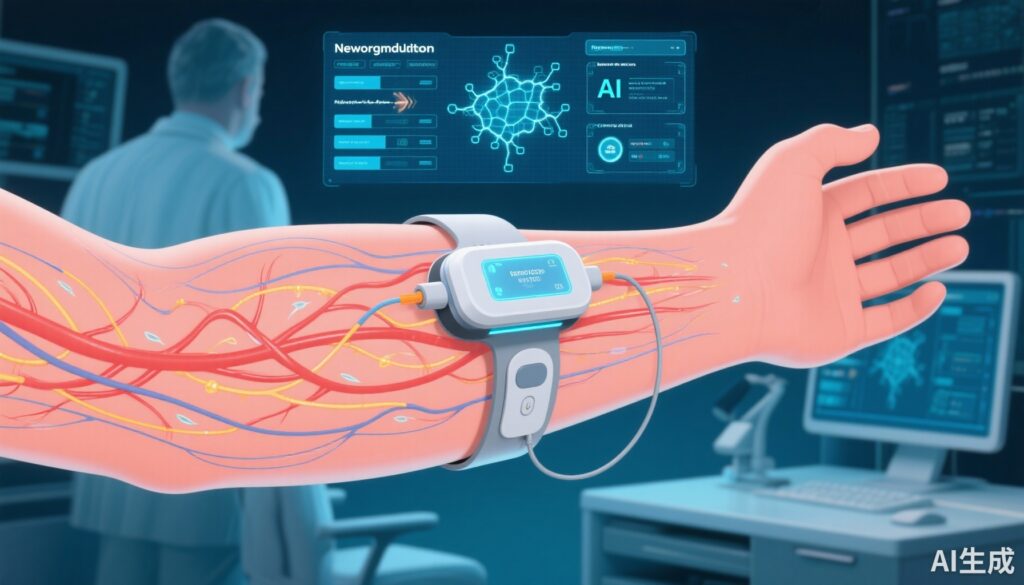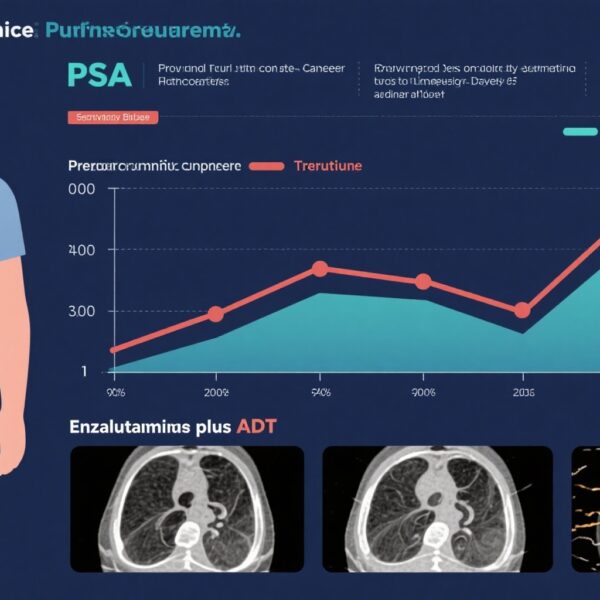Highlights
- An AI-driven transcutaneous peripheral nerve stimulation (TPNS) device significantly improved activities of daily living (mADL scores) related to upper limb tremor in ET at 90 days compared to sham.
- Evidence synthesis from clinical trials shows peripheral nerve stimulation (PNS) can modulate tremor amplitude and severity, offering a safe and noninvasive therapeutic option.
- Real-time AI adjustment of stimulation parameters targeting radial, median, and ulnar nerves enhances the neuromodulation precision and clinical benefit.
- Adverse events are generally mild, with skin irritation most common; longer-term safety and efficacy require further evaluation.
Background
Essential tremor (ET) stands as the most prevalent movement disorder characterized predominantly by bilateral upper limb action tremor, impairing daily functioning and quality of life in affected adults. Conventional pharmacologic therapies, including beta-blockers and anticonvulsants, often provide incomplete symptom control and carry systemic side effects. Invasive neuromodulation approaches like deep brain stimulation (DBS) are effective but limited to select patients due to surgical risks and costs.
Emerging noninvasive peripheral neuromodulation, particularly transcutaneous peripheral nerve stimulation (TPNS), offers a potentially safer and user-friendly alternative by targeting afferent sensory pathways influencing tremor central networks. This approach capitalizes on modulating the tremor-generating circuits via peripheral nerve inputs, primarily stimulating the median, radial, and ulnar nerves at the wrist or forearm. Prior devices like the Cala system have FDA clearance but demonstrated mixed efficacy in clinical trials. The recent randomized clinical trial by Ondo et al. (2025) introduces an AI-driven TPNS device promising enhanced efficacy through continuous real-time stimulation adjustment.
Key Content
Chronological and Clinical Development of Peripheral Nerve Stimulation in ET
Early pilot and single-session studies (e.g., Isaacson et al., 2019) established the safety and transient efficacy of wrist-worn PNS devices with modest improvements in tremor severity (TETRAS scores) and activities of daily living (ADL). However, improvements in objective spiral drawing or clinician-rated tremor scales were inconsistent.
Subsequent sham-controlled trials, such as the 2025 study by Zheng et al., evaluated brief (40-minute) PNS sessions showing significant reductions in tremor amplitude measured by accelerometry but less consistent subjective ADL improvements, implying that single short sessions might be insufficient for sustained benefit.
The landmark multicenter randomized clinical trial by Ondo et al. (2025) represented a methodological advance by introducing an AI-driven TPNS device designed to stimulate multiple peripheral nerves with dynamically optimized settings over a 90-day treatment period. This study randomized 125 adults with moderate to severe ET across 12 clinics in the US and China with 2:1 allocation to active vs sham stimulation, stratifying by tremor severity and medication use.
Intervention and Mechanistic Rationale
The investigational device applied continuous neuromodulation targeting the radial, median, and ulnar nerves, employing AI algorithms to monitor neural and tremor signals and adjust stimulation parameters in real-time. This adaptive neuromodulation approach contrasts with fixed-pattern stimulation of prior devices, hypothesized to better engage sensorimotor networks underlying tremor generation and suppression.
By modulating afferent sensory fibers, the device presumably influences central oscillators in cerebello-thalamo-cortical circuits responsible for tremor genesis. This peripheral-central pathway modulation could reduce tremor amplitude and improve functional motor control with minimal invasiveness.
Study Outcomes
The primary endpoint was change in the modified Activities of Daily Living (mADL) subscale of the Essential Tremor Rating Assessment Scale (TETRAS) over 90 days. Results demonstrated a statistically significant mean improvement of 6.9 points (95% CI 5.4-8.4) in the TPNS group versus 2.7 points (95% CI 1.3-4.0) in sham (P < .001).
Secondary efficacy indicators, though not detailed in the primary publication abstract, are suggestive from similar prior studies of clinically meaningful functional gains and tremor severity reductions.
Adverse events were predominantly skin irritation at electrode sites (33.7% active vs 4.8% sham), typically mild. Less common events in the active group included nausea, arthralgia, exacerbation of arthritis, muscle weakness, and involuntary contractions, each reported in isolated participants.
Comparative Evidence from Other Peripheral Nerve Stimulation Trials
Similar randomized controlled trials (RCTs) before Ondo et al.’s study reinforced PNS as a promising modality:
- The 2019 RCT by Isaacson et al. showed immediate but transient improvements in tremor scales and ADLs after a single neuromodulation session.
- The 2025 short-term trial by Zheng et al. highlighted significant accelerometer-based tremor amplitude reductions but no sustained subjective or clinician-rated benefits at 24 hours.
- Reviews of devices such as the Cala wrist-worn peripheral nerve stimulator reflect a well-tolerated safety profile but mixed efficacy results with effect sizes of 20%-25% improvement in tremor severity and ADLs at 3 months.
Safety Profile and Tolerability
Peripheral nerve stimulation devices are generally safe with low risks of serious adverse events. Common local side effects are skin irritation or mild discomfort. The AI-driven device investigated in the latest trial maintains this safety standard, though close monitoring is warranted for patients with pre-existing arthritis or neuromuscular disorders to anticipate possible exacerbations.
Expert Commentary
The significant improvement in activities of daily living attributable to the AI-driven TPNS device over prolonged 90-day usage marks a pivotal enhancement over prior fixed-stimulation paradigms and single-session studies. The integration of artificial intelligence offers personalized neuromodulation, accommodating individual tremor dynamics and potentially optimizing therapeutic outcomes.
Methodologically, stratified randomization, multisite enrollment, and intention-to-treat analyses strengthen the validity of these findings. However, the relatively high incidence of device-related skin irritation highlights the importance of design refinements for improved wearability and dermatologic compatibility.
Despite encouraging functional improvements, objective tremor amplitude measurements and blinded clinician-rated assessments beyond the mADL remain important endpoints for future studies to corroborate and expand on these findings. Furthermore, long-term follow-up beyond 90 days is needed to establish durability and monitor late-emerging effects.
From a mechanistic perspective, peripheral neuromodulation plausibly disrupts pathological oscillatory activity within cerebellothalamic circuits by afferent sensory input alteration, offering an alternative to central neurosurgical interventions. This noninvasive paradigm aligns with a growing trend toward bioelectronic medicine authored by precision neurostimulation and adaptive feedback systems.
Conclusion
The 2024 randomized clinical trial by Ondo et al. robustly demonstrates that AI-driven transcutaneous peripheral nerve stimulation is a safe and effective noninvasive treatment modality for essential tremor, improving patient-centric functional outcomes at 90 days. These results support TPNS as an emerging clinical option for ET patients, especially those seeking alternatives to pharmacotherapy or invasive surgery.
Pending further validation in larger, longer-term and objective efficacy studies, TPNS devices with adaptive AI algorithms may become integral in personalized tremor management. Advances in device ergonomics and integration with digital health platforms are anticipated to enhance adherence and real-world effectiveness.
References
- Ondo WG, Lv W, Zhu X, et al. Transcutaneous Peripheral Nerve Stimulation for Essential Tremor: A Randomized Clinical Trial. JAMA Neurol. 2025 Oct 20. doi: 10.1001/jamaneurol.2025.3905. PMID: 41114984.
- Zheng W, et al. Short-term efficacy of peripheral nerve stimulation for essential tremor in a randomized double-blind controlled trial. Sci Rep. 2025 Aug 6;15(1):28713. doi: 10.1038/s41598-025-13487-1. PMID: 40770217.
- Isaacson SH, et al. An Acute Randomized Controlled Trial of Noninvasive Peripheral Nerve Stimulation in Essential Tremor. Neuromodulation. 2019 Jul;22(5):537-545. doi: 10.1111/ner.12930. PMID: 30701655.
- Gironell A. Rationale and Evidence for Peripheral Nerve Stimulation for Treating Essential Tremor. Tremor Other Hyperkinet Mov (N Y). 2022 Jun 14;12:20. doi: 10.5334/tohm.685. PMID: 35949227.


